JTF (just the facts): A total of 13 photo-collages nailed to five white walls of the gallery. Nine are arrayed in a line on the West wall; they range in size from roughly 8×16 inches to 12×23 inches. Four others are murals. The largest is sized roughly 240×500 inches and hangs on the South wall; the other three are of slightly smaller dimensions (230×352 inches; 233×197 inches; 232×238 inches) and clustered on three walls in a cul-de-sac. All the works are made from multiple photo-offset prints, fastened together with tape, and covered with plastic sheets.
In addition, two pine-wood vitrines near the entrance contain an array of explanatory materials, including a series of much smaller photo-collages, paperback and hardcovers books by European and American intellectuals, a reprint of a NYT op-ed piece, a copy of Marie Claire magazine, and texts about his process by the artist. (Installation shots below.)
Comments/Context: The righteous energy that fuels Thomas Hirschhorn’s installations can be so overwhelming that it’s easy to ignore how confused and self-defeating they sometimes are.
His motives are commendable. Over the last two years, for his Pixel-Collage series, he has aimed to confront the terrible, and frequently hidden, realities of suffering by presenting in public spaces gruesome photographs of violence to anonymous bodies. Every government, going back to the mid-19th century, has done its best to prevent all but a select few from viewing images like these, unless they support what a country’s leaders want to convey about the actions of their police and military. Polite society has always deplored graphic photos as well, preferring newspapers and magazines that refused on principle to publish them. Pictures of the maimed or dead are shielded from wider view by editors who see it as their job to “protect” the public, especially children, from exposure to such sights.
Hirshhorn believes that access to such imagery should not be thwarted by the forces (technological as well as socio-political) that govern our consumption of information. Like Edward Snowden and Julian Assange, he trusts that the people—or at least himself—should decide what can and cannot be seen, not the gatekeepers. “’Pixelation,’ blurring or masking and furthermore censorship and self-censorship, is a growing and an insidious issue, also in the social media today,” he writes in the gallery press release.
His means are also beyond reproach. He abjures the high-tech toys and expensive printing that, say, Richard Mosse has marshaled for his work about civil wars in Africa and mass immigration. Hirshhorn chooses instead to make his points with the cheapest materials at his disposal: reproductions and typed labels on printer paper, masking tape, paperback books in pinewood cases, plastic wrap. He makes collages because they are elemental forms, and he fixes them to the walls with nails.
If the arte povera populism of his humble method is St. Francis of Assisi’s, the scorching tone of the message is Martin Luther’s. By Hirshhorn’s reasoning, only the individual, not institutions, should have the right to determine what can be shown. The Swiss artist’s command of English is not flawless but his passion is immaculate. “I don’t accept that, under the claim of ‘protecting’—protecting me, protecting the other—the world is pixelated in my place,” he writes. “I want, I can, I need, I must use my own eyes to see everything in our world, as act of emancipation….I want to ‘de-pixelate’ the world, I want to live in a de-pixelated world.”
For reasons he doesn’t specify, De-Pixelation is to be the last of his Pixel-Collages. Four enormous examples, covered in plastic, occupy four different walls. In each of them a corpse (in various states of rigor mortis) shares space with pixelated figures or things. The abstract squares prevent us from knowing for sure but these elements of the collage seem to be unrelated, scenes of people extracted from fashion magazines.
The trick is one of inversion: the photo that is usually censored by news outlets (a severed head, a sticky pool of blood) he has reprinted without pixels; a photo of women with luggage on a street is made almost illegible because of editorial blurring, presumably by his own hand.
The artist himself describes these works as “difficult.” A more accurate word might be “befuddled.” He seems to have had no trouble in finding images of horrific violence on the internet, so it’s not clear why he should be so worked up about issues of censorship. Photos of this kind seldom appear on the front pages of newspapers or on evening newscasts for various reasons, and not always from fear of offending prudish readers or advertisers. Desensitization to violence by repetitive and decontextualized reproduction of bullet-ridden bodies is as much an “insidious” danger as squeamishness about bodily fluids.
Hirshhorn’s installations often feature as many words as images, if not more. That’s certainly the story here. Apart from the 2000 word statement in the press release, he has placed numerous typed texts in the wooden vitrines near the entrance. One group of thoughts is organized around the subject of pixelation and broken down into the nine categories: 1. Decision. 2. Authority. 3. Abstraction. 4. Facelessness. 5. Pushed to the Edges. 6. Aesthetics. 7. The worse is censored. 8. Hypocrisy. 9. Authenticity.
Several statements seem intended mainly as provocation. For instance, he writes in section 8: “I am interested in pixelation because it reveals the hypocrisy of the one using it. I don’t accept pixelation in my place ‘to protect me,’ when the one pixelating claims the opposite, and is in fact protecting himself.”
As he must know, this isn’t always true. When the faces of bystanders at a murder scene are blurred, it may be to protect them from retaliation by gangs who could (rightly or wrongly) target them as potential witnesses. Newspaper editors have been censoring photos of bloody car crashes for more than a century, primarily because the parents of a teenage boy whose head went through a windshield might be even more devastated if photos of their mutilated son were published in their hometown gazette. Naked children are often pixelated in case pedophiles might try to identify them.
Hirschhorn can denounce these examples as authoritarian censorship if he likes; another word might be empathy or precaution.
The absolutism of his principles is intoxicating but it doesn’t recognize some legitimate personal strategies for censorship and self-censorship in the digital era. There are sound political reasons not to click on videos of beheadings produced by ISIS. As long as the internet counts “hits” as evidence of popularity, watching these snuff films is abetting a death cult and creating economic incentives for it to kill and film more people. Sometimes the last defense against aggressive propaganda is to pretend it doesn’t exist. A social media frenzy of views, pro or con, only stokes this reality with more oxygen.
Exposing gallery goers to photos of severed headed isn’t radical either; art history textbooks are full of them. And nowhere does Hirshhorn express interest in the sources of violence. Rather than pay respects to the dead by naming them or seeking to identify reasons why they were killed—a job that editors in the mainstream media take seriously—he leaves the bodies where the photographer found them. In a series that pretends to be about individuals and legibility, he makes spectacular-sized murals in which some of the anonymous souls are hard to see. No matter where I stood in the galleries, the reflective glare of the lights off the plastic sheets interfered with a complete and unvarnished view. Doesn’t his sloppy method here then further, and unnecessarily, censor issues that he claims these works are supposed to dramatize and reveal?
Critics and curators have swooned over Hirschhorn because he does what they hope to do. Like Adrian Piper, Hans Haacke, Victor Burgin, and Marcus Steinweg, he is a cultural philosopher as well as a visual artist. The vitrines contain familiar books in English, German, and French by Susan Sontag, Robert Walser, Georges Bataille, as well as texts that aren’t on every bien-pensant’s reading list, such as the English translation of Steinweg’s The Terror or Evidence and the writings of the German abstract painter and sculptor Otto Freundlich.
Hirschhorn is bursting with ideas, some of which have kernels of truth. “What interests me is that pixelating has taken over the role of authenticity,” he writes. “Partly pixelated pictures look even more authentic and are accepted as such. Pixels stand for authentication: authentication through authority because to pixelate is always an authoritarian act.”
An idealist who wants to be the pilot of his own ship, and to sail the unmediated seas of the world without a need for consulting charts (because nautical science is authoritarian?) Hirschhorn writes with the unstoppable confidence of someone who is not used to being edited or questioned, and he should be.
When his theorizing is strictly in focus, the results can be spellbinding. His 2012 silent video, Touching Reality, is a masterpiece. The horrific images of torn-apart bodies, downloaded from the internet and manipulated on the screen by fingers moving across an iPad—gaping head wounds and body cavities opened and closed by finger and thumb—were assembled with a cold intelligence. De-Pixelation is warmer and funkier, but whatever insights into photography, censorship, morality, technology, and violence it may propose are canceled out by the slipshod presentation of the collages and the half-baked, contradictory ideas that support them.
Collector’s POV: The works in this show are priced as follows. The smallest photo-collages begin at €15000 while the largest are €1000000 and up. In recent years, Hirschhorn’s photographic works have had little secondary market activity. As such, gallery retail likely remains the best option for those collectors interested in following up.
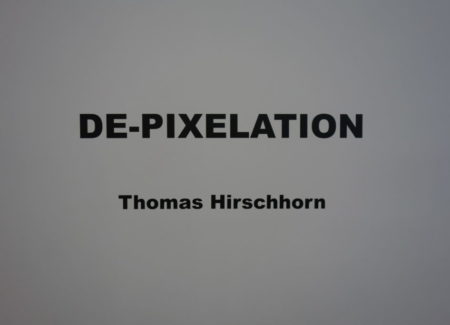
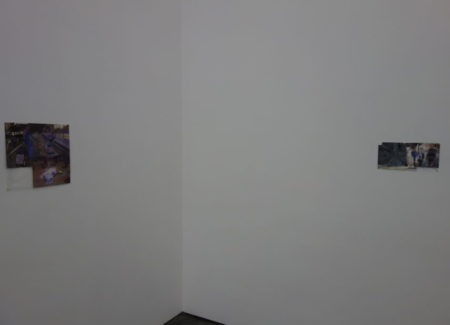

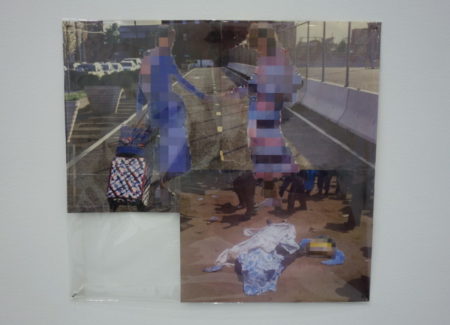





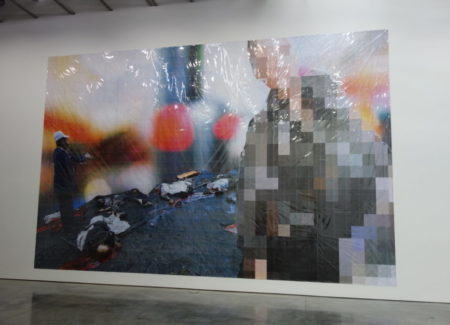

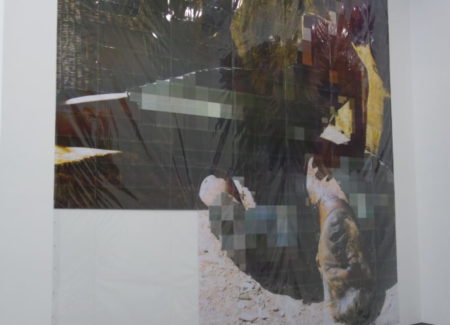
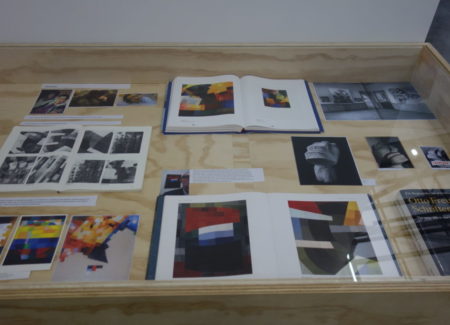

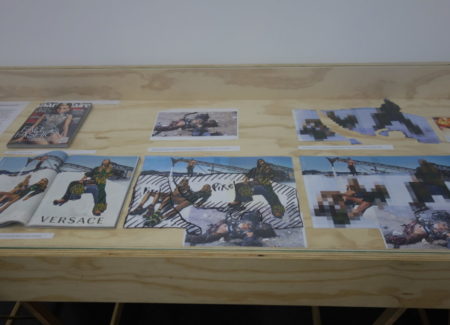






The de-bunking is excellent, being detailed and effective. But, let’s face it, on the whole, most photographers (like most contemporary fiction writers) are actually fairly dim. Especially the ones who attempt to present as intellectual, invariably the dimmest of all. That shouldn’t, I don’t think, be a major incumbrance to appreciating the fruits of an absurd methodology and deeply flawed thinking, such as here (or in an entertaining read), if that outcome is compelling enough despite those failings. Which I think it is here.
The murals (which perhaps should be exhibited before being disposed of) have achieved something vital. That ‘righteous energy’ succeeds through the slipshod final object, being simultaneously appalling and visually urgent. The utilisation of the pixel motif is spot-on.
It is a confusion of contradictory ideas, and also infuriatingly avaricious in pricing, but there’s a need for this show. Photography needs a regular jolt of mentalness, if only to contrast with the endless supply of low-risk undertakings.